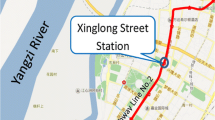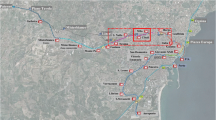Abstract
Historically, underground structures were considered to be less vulnerable to earthquakes. However, some of the recent earthquakes have demonstrated that underground structures too can suffer severe damages, especially when these are located in the vicinity of causative faults. In case of a shallow underground tunnel excavated in an urban area, design and construction is demanding due to interaction between the tunnels and the overlying pre-existing structures. Selection of a realistic ground motion of an earthquake plays a crucial role in the seismic analysis and design of underground structures. In the absence of realistic earthquake data for the given area, it becomes essential to generate artificial or synthetic time history compatible with the largest earthquake expected in that area. Depending upon the situation, it may become necessary to consider three-dimensional aspects of the problem rather than depending on only a two-dimensional behavior. Strong ground shaking can as well cause loss of strength in saturated cohesion less soils resulting in liquefaction. Liquefaction can cause the ground surrounding the tunnels to shift, with potentially severe consequences. An attempt has been made in this paper to discuss various analysis and design considerations of underground lifeline structures and then look in to the aspects of stability of metro underground tunnels of Delhi city on basis of response spectra compatible time histories of 1999 Chamoli earthquake of Uttarakhand, actual three-dimensional analyses, and some liquefaction studies.




















Similar content being viewed by others
References
Hashash YA, Hook J, Schmidt B, Chiangyao J (2001) Seismic design and analysis of underground structures. J Tunnel Undergr Space Technol 16(4):247–293
Dowding CH, Rozen A (1978) Damage to rock tunnels from earthquake shaking. J Geotech Eng 2:175–191
Kumar A (2006) Software for generation of spectrum compatible time history having same phase as of a given time history. In: Proceedings 8th U.S. National conference on earthquake engineering, San Francisco, California, USA, April 18–22, Paper No. 172
Abrahamson NA (2010) Nonstationary spectral matching program RSPMATCH. User’s manual (1992)
Gasparini DA, Vanmarcke EH (1976) Simulated earthquake motion compatible with prescribed response spectra. Massachusetts Institute of Technology, Department of Civil Engineering, Constructed Facilities Division, Springfield, VA: Distributed by National Technical Information Service, U.S. Dept. of Commerce
Silva WJ, Lee K (1987) WES RASCAL Code for synthesizing earthquake ground motions. Miscellaneous paper S-73-1. Report 24, US Army Core of Engineers, Waterways Experiment Station, Vicksburg, Missisippi, p 73
Lilhanand K, Tseng WS (1988) Development and application of realistic earthquake time histories comparable with multiple damping design spectra. In: Proceedings 9th world conference on earthquake engineering, Tokyo-Kyoto, Japan, vol 2
Bolt BA, Gregor NJ (1993) Synthesized strong ground motions for the seismic condition assessment of the eastern portion of the San Francisco Bay Bridge. Report UCB/EERC-93/12, Earthquake Engineering Research Center, University of California, Berkeley, CA
Gupta ID, Joshi RG (1993) On synthesizing response spectrum compatible accelerograms. Proc Eur Conf Earthq Eng 7(2):25–33
Shrikhande M, Gupta VK (1996) On generating ensemble of design spectrum-compatible accelerograms. J Eur Earthq Eng 3:49–56
Conte JP, Peng BF (1997) Fully nonstationary analytical earthquake ground motion model. J Eng Mech ASCE 123(1):15–24
Shrikhande M, Gupta VK (2011) On the characterization of the phase spectrum for strong motion synthesis. J Earthq Eng 5(4):465–482
Atik LA, Abrahamson N (2010) An improved method for nonstationary spectral matching. J Earthq Spectra 26(3):601–617
Singh M, Viladkar MN, Samadhiya NK (2017) Seismic response of Delhi metro underground tunnels. Int J Geotech Eng 11(2):175–185
Trifunac MD, Udwadia FE, Brady AG (1971) High frequency errors and instrument corrections of strong-motion accelerogram. Earthquake Energy Res. Lab. EERL 71-05, CALTECH., Pasadena, California
Wong HL, Trifunac MD (1979) Generation of artificial strong motion accelerograms. J Earthq Eng Struct Dyn 7:509–527
Basu B, Gupta VK (1999) Wavelet-based analysis of non-stationary response of a slipping foundation. J Sound Vib 222(4):547–563
Fahjan Y, Ozdemir Z (2008) Scaling of earthquake accelerograms for non-linear dynamic analyses to match the earthquake design spectra. In: 14th world conference on earthquake engineering, Beijing, China, pp 12–17
Katsanos EI, Sextos A, Manolis GD (2010) Selection of earthquake ground motion records: a state-of-art review from a structural engineering perspective. J Soil Dyn Earthq Eng 30(4):157–169
Singh M (2018) Seismic response of shallow metro underground tunnels. Ph.D. thesis, Department of Civil Engineering, IIT Roorkee, India
IS: 1893 Part-1 (2002) Code of practice: criteria for earthquake resistant design of structures. Bureau of Indian Standards, (BIS), Manak Bhawan, New Delhi
Sony S (2015) Static and dynamic response of Delhi metro tunnels. Ph.D. thesis, Department of Civil Engineering, IIT Delhi, India
Yadav HR (2005) Geotechnical evaluation of Delhi metro tunnels. Ph.D. Thesis, Department of Civil Engineering, IIT Delhi, India
Lysmer J, Kuhlemeyer RL (1969) Finite dynamic model for infinite media. J Eng Mech 95:859–878
Sliteen I, Mroueh H, Sadek M (2011) Three-dimensional modeling of the behavior of shallow tunnel under seismic loading. Laboratory of Civil Engineering and GeoEnvironment (LGCgE), University of Lille, 1-Polytech-Lille, France
Li P, Song EX (2015) Three-dimensional numerical analysis for the longitudinal seismic response of tunnels under an asynchronous wave input. J Comput Geotech 63:229–243
Stamos AA, Beskos DE (1995) Dynamic analysis of large 3-D underground structures by the BEM. J Earthq Eng Struct Dyn 24(6):917–934
Stamos AA, Beskos DE (1996) 3-D seismic response analysis of long lined tunnels in half-space. J Soil Dyn Earthq Eng 15(2):111–118
Yu H, Yuan Y, Bobet A (2017) Seismic analysis of long tunnels: a review of simplified and unified methods. J Undergr Space 2:73–87
Yu H, Yuan Y, Chen Z, Yu G, Gu Y (2009) Full 3D numerical simulation method and its application to seismic response analysis of water-conveyance tunnel. J Comput Struct Eng 19:349–358
Chen Z, Yu H, Yuan Y (2014) Full 3D seismic analysis of a long-distance water conveyance tunnel. J Struct Infrastruct Eng 10(1):128–140
Ichimura T, Tanaka S, Hori M, Yamamoto Y, Dobashi H, Osada M, Ohbo N, Yamada T (2016) Full three-dimensional seismic response analysis of underground structures with large complex cross sections and two-step analysis method for reducing the computational costs. J Earthq Tsunami 10(5):1640016
Chun LD, Qi LV, Li DX, Chao M (2015) Three dimensional seismic response analysis of tunnels and surrounding rock. J Disaster Prev Mitig Eng 02
Singh M, Viladkar MN, Samadhiya NK (2018) Three dimensional seismic analysis of metro underground tunnels. In: Proceedings international conference advances in construction materials and structures, Department of Civil Engineering, IIT Roorkee
Kramer SL (1996) Geotechnical earthquake engineering. Pearson Education Inc. and Dorling Kindersley Pub. Inc., London
Prakash S (1981) Soil dynamics. McGraw Hill, New York. Reprinted SP Foundation, Rolla, MO, USA
Hashash YA, Hook J, Schmidt B, Chiangyao J (2005) Seismic design and analysis of underground structures. J Tunnel Undergr Space Technol 20(5):435–441
Azadi M, Mohammad SM (2010) Analyses of the effect of seismic behavior of shallow tunnels in liquefiable grounds. J Tunnel Undergr Space Technol 25(5):543–552
Azadi M (2011) The seismic behavior of urban tunnels in soft saturated soils. In: Proceedings 12th East Asia Pacific conference on structural engineering & construction, procedia engineering, vol 14, pp 3069–3075
Bao X, Xi Z, Ye G, Fu Y, Su D (2017) Numerical analysis of the seismic behavior of a large metro subway tunnel in liquefiable ground. J Tunnel Undergr Space Technol 66:91–106
Liu H, Song E (2005) Seismic response of large underground structures in liquefiable soils subjected to horizontal and vertical earthquake excitations. J Comput Geotech 32(4):223–244
Salehzadeh H, Parchami ML (2014) Seismic analysis of twin tunnels in liquefiable soils. J Transp Res 2(39):125–158
Unutmaz B (2014) 3D liquefaction assessment of soils surrounding circular tunnels. J Tunnel Undergr Space Technol 40:85–94
Viladkar MN, Singh M, Samadhiya NK (2019) Liquefaction analysis of metro underground tunnels. In: 7th international conference earthquake geotechnical engineering, Rome, Italy, June
Tsegaye A (2010) Plaxis liquefaction model. External report. Plaxis knowledge base, http://www.plaxis.nl
Funding
Necessary finding for this work was received from The Ministry of Human Resources Development (MHRD), New Delhi, India.
Author information
Authors and Affiliations
Corresponding author
Ethics declarations
Conflict of interest
The authors declare that they have no known conflicting financial or any other interests.
Additional information
Publisher's Note
Springer Nature remains neutral with regard to jurisdictional claims in published maps and institutional affiliations.
Rights and permissions
About this article
Cite this article
Viladkar, M.N., Singh, M. Some Aspects of Seismic Soil–Structure Interaction of Lifeline Structures. Indian Geotech J 51, 482–501 (2021). https://doi.org/10.1007/s40098-021-00523-w
Received:
Accepted:
Published:
Issue Date:
DOI: https://doi.org/10.1007/s40098-021-00523-w




